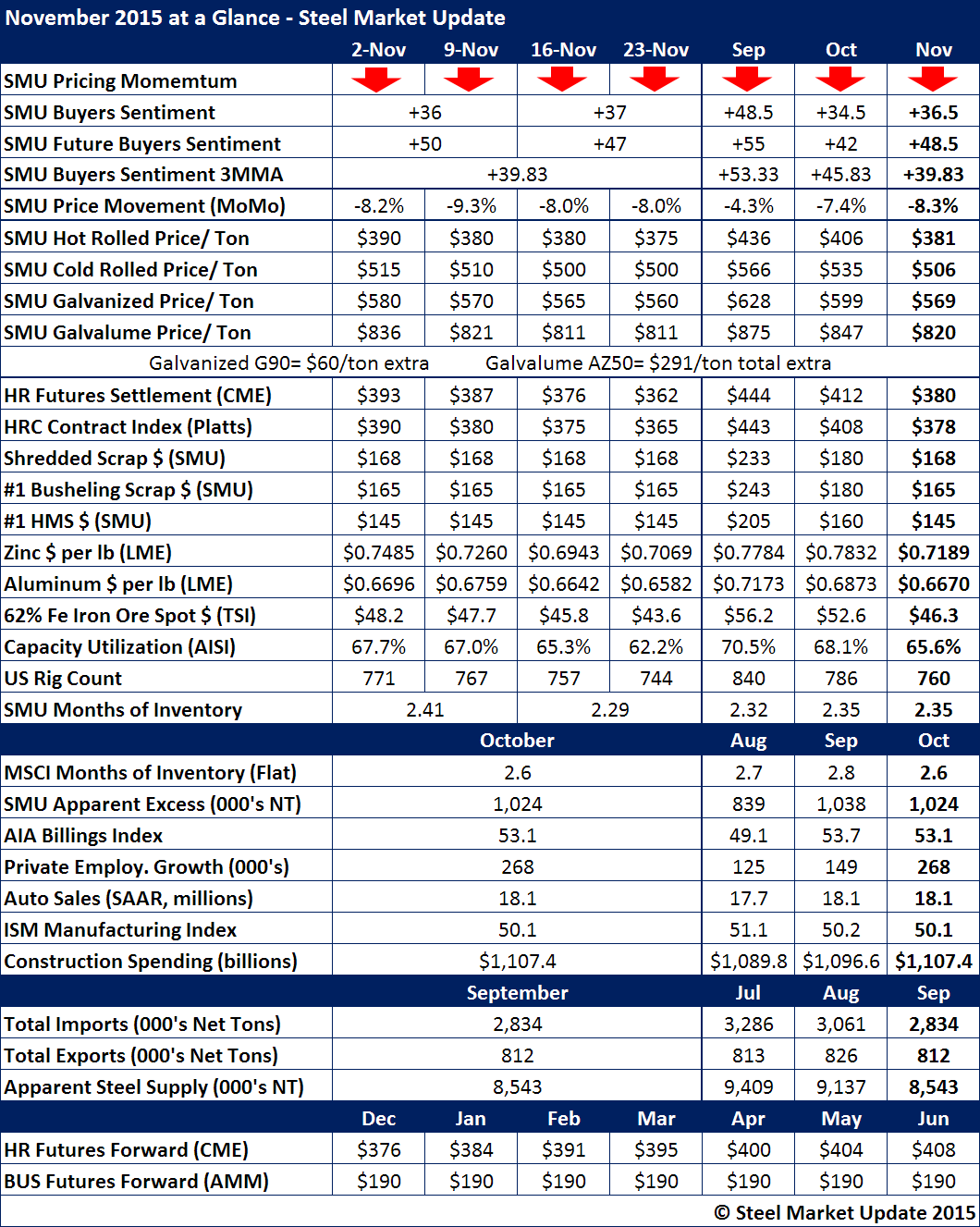SMU Data and Models

November at a Glance
Written by John Packard
December 1, 2015
The month of November saw a continuation of lower flat rolled steel prices, Momentum and Sentiment as buyers and sellers struggle to find a bottom to what has become an extended slide going back to May 2015.
November benchmark hot rolled prices (SMU average) Dropped $15 per ton during the course of the month and are now down $310 per ton from the market cycle peak achieved on May 13, 2015 at $685 per ton.
The extended drop in prices can be attributed to a number of factors many of which are spelled out in the table shown below:
• Scrap prices were down an average of $15 per gross ton (some market more, east coast was less).
• Iron ore spot prices in China dropped $6.70/dmt on 62% Fe fines since the end of October until the last day of November.
• Domestic (USA) steel mill capacity utilization rates dropped during the month ending last week at 62.2%.
• SMU service center Apparent Excess flat rolled inventories continues to be above 1 million tons. However, Apparent Excess was forecast to reach 1.2 million tons so the number is a net positive as it is going in the right direction (Apparent Excess is a Premium product).
• Imports were down but were still well above the 22-24 percent of total apparent steel supply.
SMU Sentiment Index 3 month moving average (3MMA) has been steadily becoming less optimistic having gone from +53.33 in September to +39.83 during November.
The HRC Futures markets are not painting a rosy picture for the next seven months as they have HRC prices moving up to $408 per ton by the month of June.

John Packard
Read more from John PackardLatest in SMU Data and Models

Apparent steel supply remained high in May
The volume of finished steel entering the US market remained elevated in May, in line with April figures, according to SMU’s analysis of Department of Commerce and American Iron and Steel Institute (AISI) data

June service center shipments and inventories report
Flat rolled = 55.8 shipping days of supply Plate = 59.4 shipping days of supply Flat rolled US service centers’ flat-rolled steel supply edged down in June with a modest boost to shipments month on month (m/m). At the end of June, US service centers carried 55.8 shipping days of flat roll supply, down from […]

SMU Scrap Survey: Sentiment Indices rise
Both current and future scrap sentiment jumped this month, though survey participants reported responses before key trade news was announced.

SMU Survey: Sentiment splits, buyers have better view of future than the present
SMU’s Steel Buyers’ Sentiment Indices moved in opposite directions this week. After rebounding from a near five-year low in late June, Current Sentiment slipped again. At the same time, Future Sentiment climbed to a four-month high. Both indices continue to show optimism among buyers about their company’s chances for success, but suggest there is less confidence in that optimism than earlier in the year.

SMU scrap market survey results now available
SMU’s ferrous scrap market survey results are now available on our website to all premium members. After logging in at steelmarketupdate.com, visit the pricing and analysis tab and look under the “survey results” section for “ferrous scrap survey” results. Past scrap survey results are also available under that selection. If you need help accessing the survey results […]

